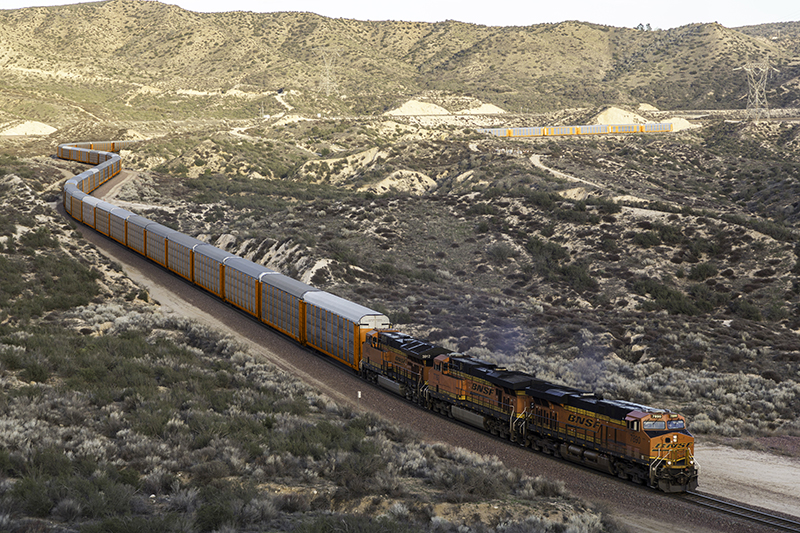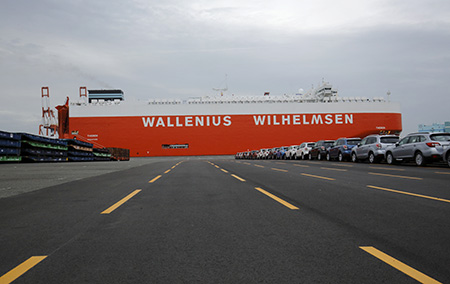 As with most things in life, change is a constant in automotive logistics, but in finished vehicle distribution that doesn’t seem to hold as true. As one observer wryly comments about vehicle logistics: “The way of doing things is cemented because that’s how it’s always been done.”
As with most things in life, change is a constant in automotive logistics, but in finished vehicle distribution that doesn’t seem to hold as true. As one observer wryly comments about vehicle logistics: “The way of doing things is cemented because that’s how it’s always been done.”
Being asset heavy, fewer third-party logistics (3PL) providers have muscled into the sector than in other parts of the supply chain over the past 30 years. With a relatively small number of specialist carriers providing ships, barges, trains and road transporters, and serving a relatively small number of vehicle manufacturers, this sector has proven infertile ground for the likes of 3PLs that offer bundled services across a mix of transport and storage assets that they often don’t own.
Bruce Arlinghaus, who has run major 3PLs, including Ryder in Europe, as well as working for vehicle logistics companies as a consultant for Eurobeacon, points out that vehicle logistics cannot be easily compared to other third-party logistics businesses. “High-value, vulnerable finished products are carried on expensive, specialist equipment not readily useable for other tasks. Also, skilled and experienced drivers are required,” he notes.
Arlinghaus compares the sector to armoured truck cash delivery services, which have consolidated into a small number of global providers. “It costs a lot of money to transport money safely and securely, [via] asset investment and maintenance, highly trained and paid staff, security and insurance,” he says. Vehicles, in many ways, are no different.
One thing that makes it difficult for 3PLs and others to become involved in finished vehicle logistics is the specialised equipment required, and its relatively high costs. Car transporters and railway wagons have to be constructed in a very special way to meet the particular requirements of customers, points out Michael Bronsert, head of sales at ARS Altmann.
“Easy and quick unloading and loading, and a safe transport of finished vehicles, can exclusively be guaranteed when using specific assets, which are more expensive in procurement and maintenance than regular equipment for general cargo. Their usage is limited to one unique purpose, whereas general cargo is flexible and provides more opportunities of transport,” he says.
Though it might be possible to redesign car carriers to reduce the almost inevitable lack of backhaul potential, the idea has a drawback, says Bruce Arlinghaus. “While the equipment may become more operationally flexible, a common freight backhaul operated by a higher skilled and paid vehicle logistics driver represents a serious under-employment of an increasingly scarce human resource,” he states.
Indeed, technological changes in vehicles and society could eventually upend the traditional structure of the vehicle logistics market, whether from autonomous driving, e-commerce or electric vehicles. But there are many reasons to think that such change, if it comes at all, will continue to be slow in this sector.
Where can 3PLs add value?Nevertheless, some parts of vehicle logistics, including US railway operators, give little truck to the idea of 3PLs entering the vehicle logistics segment – especially for specialised rail services. David Fleenor, assistant vice-president of automotive at class one railway BNSF, thinks the railways, which move 75% of new cars and trucks in North America, offer the most value by working directly with their customers. “In the movement of finished vehicles, the railroads manage the flow of railcars from plant to interchange to unloading facility, and back again. There are a lot of moving parts and competing priorities that each of us balances on our individual networks.
“There has not been a significant opportunity for a 3PL to add value to that part of the supply chain,” he maintains.
Doniele Carlson, spokesperson for Kansas City Southern (KCS), broadly agrees that rail transport is best managed between OEMs and transport providers. “The direct relationship has benefits that allow the railroad industry to understand the business more thoroughly, respond quickly to changes and better prepare for the future... This can be coupled with other modes to capitalise on density to create and manage more of the supply chain,” she states.
Bruce Arlinghaus suggests that while large global and regional 3PLs don’t do much directly in vehicle logistics, the larger vehicle logistics providers often act as 3PLs for segments of the supply chain, with carmakers having de facto outsourced much transport management along certain routes or regions. “For the OEMs, this is the best of both worlds,” he says. “Their needs get met at the most competitive rates.”
Some vehicle logistics providers, including major shipping lines, do perform a number of third-party services in other segments of vehicle logistics. Michael Hynekamp, chief operating officer at shipping and vehicle logistics firm Wallenius Wilhelmsen Logistics (WWL), points to the firm’s business in storage and port distribution centres, port processing, inland distribution and even complete supply chain management from one country to another. He thinks companies like his can help OEMs in areas where they lack the resources or local knowledge.
“Most manufacturers are rightfully focused on other disruptions in their core business and are likely to be more interested in entrusting greater levels of their vehicle logistics to trusted partners,” he says.
 "Most manufacturers are rightfully focused on other disruptions in their core business and are likely to be more interested in entrusting greater levels of their vehicle logistics to trusted partners." - Michael Hynekamp, WWL
"Most manufacturers are rightfully focused on other disruptions in their core business and are likely to be more interested in entrusting greater levels of their vehicle logistics to trusted partners." - Michael Hynekamp, WWL
However, carmakers outsourcing entire outbound supply chains remains relatively rare. And many vehicle logistics providers regard their core transport assets as strengths. Paul Steininger, international sales and business development director for Austria’s Hödlmayr International, points to its trucking, rail and storage operations across Europe serving major OEMs. “[We] offer, directly to the OEM, concepts and solutions with our own assets, trucks, rail wagons, compounds. We believe this is a major benefit as we can react quicker to shifts in demand and are not depending on sub-contractors to a high extent,” he says.
Steininger expects things to stay as they are for the foreseeable future. “Finished vehicle logistics is very transparent. Most trucks are open and you can see the customers’ products on the trailer. So you basically know who owns the contract.”
Manuel Medina, finished vehicle distribution manager at Seat, thinks there are few non-asset players because the business structure in vehicle distribuiton has not benefitted from the optimisation dynamics seen elsewhere in the supply chain since the mid-1980s. Distribution is frequently integrated into the sales division and, especially when carried out through importers, is more commercial-orientated than it is industrial. That results in distribution being even more removed from manufacturers’ core business.
[mpu_ad]Furthermore, vehicle logistics providers are often medium-sized, family-owned companies, which are not always able to invest in new technology and innovation. “Services offered by LSPs have been increasingly similar, often becoming a commodity, whereby the decision to buy is based on the lowest price with no other differentiation, except on rare occasions,” he says.
It’s about time for just-in-timeBut Medina is anticipating changes, some of which will come from improvements in how Seat plans and releases vehicles. Logistics providers typically plan and allocate transport once lots of vehicles have already been manufactured. “What manufacturers should do to help [LSPs] is to work on our forecasts so carriers can plan in advance,” he says.
Seat also plans to improve this process with the introduction of a ‘virtual holding area’, which will come into operation in the second half of 2019. With this process, distribution suppliers will have five days’ notice in advance down to the precise shift of when a batch will be ready for transport.
“We hope to be able to synchronise the time when the last car of each transport batch is fully made with the arrival of the means of transport at the factory to take delivery, in a kind of outbound just-in-time,” says Medina. The target is a reliability rate close to 99%, which should enable the company’s logistics contractors to improve dramatically how they manage their capacity.
Seat also plans to implement paperless distribution next year, whereby a truck driver receives in advance, on mobile devices, documentation related to the vehicles they are picking up at Martorell. “This would not only speed up their entry, but they would also know which cars to load and where they are located, so they could go directly to where the cars are without the current procedures,” he added.

Hand-in-hand with those changes, the Martorell layout is being altered to reduce wasted time by shortening the distance truck drivers have to cover to pick up loads at the plant.
Technology-led changeMore tightly timed schedules, closely aligned to IT systems and visibility, would make outbound logistics more like other high-value sectors that 3PLs serve. At DHL, Michael Martin, responsible for global strategy in the provider’s automotive supply chain, has been looking to see what opportunities there are for the company in vehicle logistics, and he has a sense that they may well lie in visibility and technology.
Though he concedes that introducing innovation through technology is more difficult in a capital-intensive sector, the pace of technology-led changes means “there are now opportunities to bring stakeholders in vehicle logistics together so that they can make their operations more efficient through synchronisation. That’s DHL’s strength, it’s our DNA.”
For much of the past year, he has attended conferences and industry events to better understand the sector. Martin says his 'lightbulb' moment came with a throwaway comment at a conference when one speaker said, “I wish we had this type of efficiency in finished vehicle logistics”, in reference to the speed of delivery and visibility available in inbound logistics.
“We can make the supply chain more efficient and technology is enabling that to happen for inbound and aftermarket,” says Martin. “The ability to synchronise with all stakeholders in the chain will be critical [for outbound too].”
His work is still in the research stage and DHL is making no moves at the moment to add to the seven specialised operations it already has in automotive. That said, two things stand out from his findings to date. “The automotive supply chain is very much focused on the production of cars, which is at the centre of the supply chain. The customer is away from it, a little bit forgotten,” he observes.
Customers in this context, he explains, include all types, including whole countries, sales organisations, associations, dealers, corporates and individuals. There are many distribution channels, each with different characteristics in terms of visibility, delivery and speed. As with other types of logistics services, Martin sees more scope for manufacturers and logistics providers to use multi-brand, multi-handover centres. By having a central point to collect a vehicle, there would be savings on cost and infrastructure in individual dealerships and car showrooms, bringing economies of scale.
 Seat’s introduction of paperless distribution aims to improve the identification, location and loading of vehicles to speed up turnaround
Seat’s introduction of paperless distribution aims to improve the identification, location and loading of vehicles to speed up turnaroundWith internet sales now entering the mix, Martin also anticipates changes in outbound. Customers can increasingly configure cars to the specifications they want online; plus, most have higher expectations for visibility thanks to online tracking for other consumer purchases. Such changes are likely to increase the stakes for specific vehicle movements and logistics services.
“Vehicle logistics is very much about bulk movement, for now. But there’s more talk about connected cars and the visibility that goes with them through the supply chain. So can vehicle logistics providers meet the challenges which the OEMs are throwing at them? OEMs want more flexibility in the supply chain and more visibility,” he says.
Further changes are also likely to follow autonomous vehicles (see box, below) as well as electric vehicles. EVs present a “completely different supply chain difficulty” because of the loading factor, says Martin: they weigh more than conventional cars and their weight distribution is different. Fewer can be carried on a car transporter and distribution patterns will probably have to be changed.
Though accepting EVs will increase the weight and size of vehicles, Michael Bronsert, head of sales at European vehicle logistics provider ARS Altmann, is not too worried. “We will be able to handle these modifications without problems. An aspect that we need to keep in mind, though, is the incorporation of sensors and systems in cars that we transport,” he comments.
[related_topics align="right" border="yes"]For WWL, a greater use of electricity and alternative fuels in the future means it is already considering what impact they will have on the company’s own operations, from charging to battery servicing, says Hynekamp. Bronsert adds that operators will have to comply with new regulations to reduce fuel consumption and CO2 emissions.
The collection of data regarding vehicle movements, and analysing the resulting statistics, will become part of the routine in the future. “We are already working on new IT solutions to optimise our business model,” Bronsert adds.
Hödlmayr is also increasing investments in its systems, comments Steininger. “We believe the stronger digitalisation in processes and business models will result in different car sales structures than today,” he says.
You can, of course, always put a positive spin on change. “Our customers face as many, if not more, challenges than we do,” says Michael Hynekamp. “We have the luxury of learning from their adaptations and planning, and then incorporating this into our strategic direction.”
 "We hope to be able to synchronise the time when the last car of each transport batch is fully made with the arrival of the means of transport at the factory to take delivery, in a kind of outbound just-in-time." - Manuel Medina, Seat
"We hope to be able to synchronise the time when the last car of each transport batch is fully made with the arrival of the means of transport at the factory to take delivery, in a kind of outbound just-in-time." - Manuel Medina, Seat
The advent of autonomous vehicles looks set to alter the automotive as well as the logistics industry. “They are going to change the world,” says David Fleenor from BNSF. “The timing and scale of their impact is still a little unclear, but it’s going to be big.”
Citing potential changes in customer locations or types, such as fleet and car-sharing providers, as well as how production, volumes and distribution channels will change, WWL’s Michael Hynekamp sees challenges, as well as opportunity.
Michael Martin of DHL wonders if autonomous vehicles will drive themselves around a storage area, or even deliver themselves to a customer, whether on their own wheels or after loading themselves onto an autonomous truck. That is, if individual customers even buy them at all, rather than using them on demand.
Consultant Bruce Arlinghaus questions whether OEMs could trust driverless cars to move themselves onto driverless trucks and back off. He thinks it more likely “we will still be looking for replacements for an ageing workforce” in the years to come.
Michael Bronsert says ARS Altmann is not yet concerned about autonomous vehicles, not least as there is a long way to go in addressing insurance and liability issues. “Moreover, technology is not ready yet to make a car drive onto the car carrier on its own, or to have a self-driven truck running without a driver,” he says. “Human workers will always be needed to fix the load and to fill in the paperwork.”
Hödlmayr’s Paul Steininger also sees human skills, notably those of drivers, being as essential in the future as they are now. His company employs more than 1,000 and “we know that they are key to our success in the future.”

























![Global[1]](https://d3n5uof8vony13.cloudfront.net/Pictures/web/a/d/s/global1_726550.svgz)









